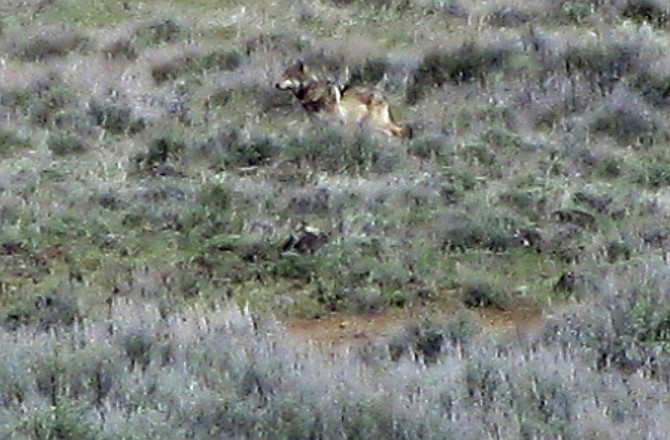FRESNO, Calif. (AP) - He doesn't like busy Interstate 5 or eating cattle, at least so far. He gets along with his distant cousins the coyotes, likes to swim and roams a lot - an awful lot - around the northernmost reaches of the Golden State.
A week or so ago, California's lone gray wolf passed his one-year anniversary as a transplant resident with the same technical accoutrements some people possess: a Twitter account and an online site about his travels.
"What strikes me about him is that when I talk to the general public they show remarkable knowledge about his movements, much more than some world events," said Richard Callas, a senior environmental scientist with the California Department of Fish and Wildlife. "Wolves captivate public interest.
"No matter how you feel about wolves, when you see one it's amazing," he added.
Far larger than coyotes, wolves were feared and hunted to near-extinction in the U.S. before being protected by the Endangered Species Act. They were reintroduced in the Northern Rockies in the mid-1990s, and some migrated into Idaho and Oregon, where they have quickly reproduced.
California's wolf is known as OR-7 because he was the seventh in Oregon to be fitted with a GPS tracking collar. While most wolves stay within 100 miles of where they were born, OR-7 proved different: he trotted 1,000 miles from northeast Oregon to California, then more than 2,000 since arriving.
Scientists speculate the 3½-year-old is looking for a mate or a new pack, though they know both prospects are remote. He is believed to be the first of the predators to roam within the state's boundaries since 1924, when the last gray wolf was killed by a trapper intent on making the West safe for cattle.
"The reality is OR-7 is not likely to find a mate in California. He'll likely pass on without successfully reproducing," said Karen Kovacs, whose job as wildlife program manager for the state Department of Fish & Wildlife has been focused lately on this one animal.
His presence has prompted action by one state and two federal agencies that now have to figure out how to manage the species if others follow in his 5-inch paw prints. Federal wildlife agencies had not considered California a part of the original western states wolf recovery plan.
Currently the state is considering a petition that would list the wolf as endangered, as he already is federally in California. Killing the wolf means a $100,000 federal fine.
If the state's wildlife commission approves the petition come October, authorities would determine how many wolves would be needed to populate a given area before the species would not be considered endangered anymore. It would include a plan to deal with livestock depredation and monitoring for disease such as distemper and rabies.
OR-7 has aroused concerns among residents of the northeastern counties who fear the wolf will kill livestock, although officials say he has not so far.
The California Cattlemen's Association opposes listing the wolf on California's endangered species list based on a single animal wandering into the state.
"Any time a predator is introduced, or in this case crosses the border, it concerns people especially those in Northern California where this wolf now seems to call his home," said Justin Oldfield, vice president of government relations for the association. "Our goal now is to work with (wildlife agencies) to see how we can manage this predator in California. That would include things such as ... what livestock owners can do to protect their animals."
The lone wolf also has been celebrated by fans such as (at)iamgreenbean who this week sent the message "We are THRILLED to have you" to the Twitter account (at)WolfOR7. The anonymous wolf often tweets about eating ungulates, or asking journalists, "Why the fixation with my love life?"
So beloved is OR-7 in Oregon that a newspaper cartoonist depicted him as a candidate during the 2012 presidential campaign.
Despite the high tech gadgetry hanging from his neck, sightings are rare. Kovac's department updates a tracking map when OR-7 moves significantly out of an area, but since July he has been hanging out mostly in Tehama County, and wildlife officers don't want the public to know exactly where. Cattle ranchers, however, are warned if he gets too close or stays too long in one area.
"When we believe he's reached a threshold, when he's hanging around in one area too long,... we have felt compelled to knock on doors and tell them to be a little more vigilant," Kovacs said.
For the past month, he has been roaming around the northern and eastern edges of Tehama County around Red Bluff as he follows deer migrating from the northern Sierra to lower grazing areas at around 1,500 feet. He has approached I-5 on several occasions, but never crossed the freeway though he has repeatedly crossed less traveled highways.
With a sample size of just one, it's hard to note any breakthroughs in wolf science, though researchers have been amazed at the distances OR-7 has covered. The 3,000 miles recorded are just connecting the dots between GPS coordinates and don't count any meandering in between.
"If you look at dispersing gray wolves, OR-7 is clearly on the far end of the bell curve in terms of how far he has traveled," Kovacs said. "He's not the first, but there are a handful that have traveled this far. That has been what's most interesting about him."

